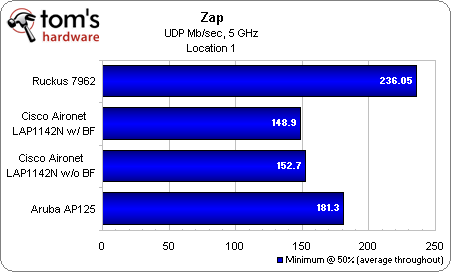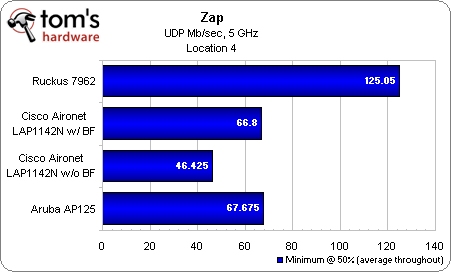Beamforming: The Best WiFi You’ve Never Seen
Zap In 5 GHz, Average
Switching to the 5 GHz band, we notice two things immediately. First, Aruba has a pulse! The AP125 handily blows past Cisco at close quarters. More importantly, though, both Ruckus and Aruba show 5 GHz numbers that are double the throughput seen on 2.4 GHz. So if you have a choice with your config, give 5 GHz a try, or at least do the throughput comparison. You may be stunned.
Life looks the same in locations 2 and 3, with Aruba still outpacing Cisco and the latter showing no benefit at all from its on-chip beamforming.
Finally, in our location 4 fortress of solitude, Cisco beamforming shows some utility, just nudging past Aruba’s non-beamforming results. Ruckus still easily kicks dust in the others’ faces.
And here’s the kicker. Down in location 5, Aruba clings by a thread to 0.1 Mbps. Cisco can’t find a connection at all. Ruckus still nearly holds 25 Mbps. If ever there was a case for a technology to adopt in long-distance scenarios, this is it. Also, harkening back to an earlier point, now you start to see why Ruckus thinks BeamFlex can cover a large space with considerably fewer APs than alternative technologies.
Get Tom's Hardware's best news and in-depth reviews, straight to your inbox.
Current page: Zap In 5 GHz, Average
Prev Page Zap In 2.4 GHz, Average Next Page Zap At 2.4 And 5 GHz, Minimum-
pirateboy just what we need, more retarded failnoobs clogging up the airwaves with useless braindead movieclips...yaayReply -
bucifer This article started up pretty good with lots of technical data and the beamforming technology in theory but after that the goodness stopped.Reply
1.You cannot compare two products by testing them with a in-house developed software. It's like testing ATI vs nVIDIA with nvidia made benchmark.
2.If you do something get it done, don't just go with half measures. I don't care if you didn't have time. You should have planned this from the beginning. The tests are incomplete, and the article is filled with crap of Rukus and Cisco. -
Mr_Man In defense of your wife, you didn't HAVE to use that particular channel to view all the "detail".Reply -
@Mr_Man: With a name like yours, I'd think that you'd sympathize with Chris a bit more :P Unless (Mr_Man == I likes men) :DReply
-
Pei-chen Both Tyra and Heidi have personal issues and would be pretty difficult friend/mate.Reply
The network idea sounds better. I couldn’t get my 10 feet g network to transmit a tenth as much as my wired network without it dropping.
-
zak_mckraken There's one question that I think was not covered by the article. Can a beamformaing AP can sustain the above numbers on two different clients? Let's say we take the UDP test at 5 GHz. The result shows 7.3 Mb/s. If we had two clients at opposite sides of the AP doing the same test, would we have 7.3 Mb/s for each test or would the bandwidth be sliced in 2?Reply
The numbers so far are astonishing, but are they realistic in a multi-client environnement? That's something I'd like to know!




